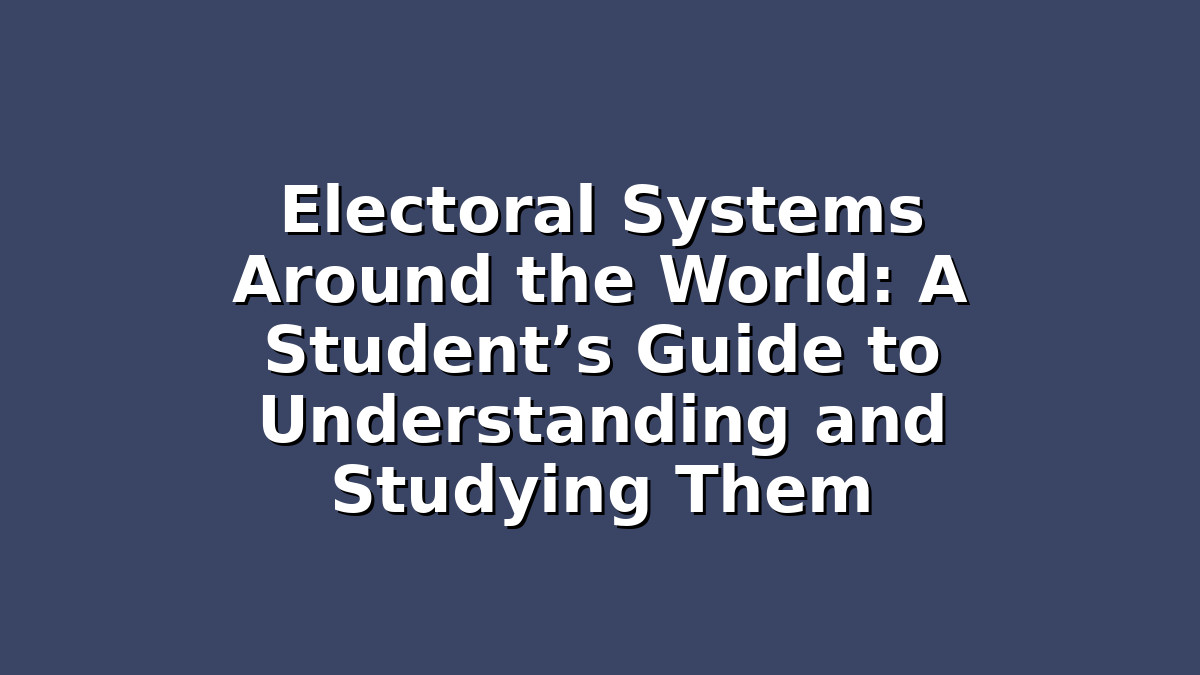When preparing for exams in subjects like political science, history, or social studies, understanding electoral systems is essential. Electoral systems determine how votes are translated into seats in a government, influencing the political landscape of countries worldwide. Whether you’re studying for a test or simply aiming to deepen your knowledge, grasping the basics of electoral systems can be challenging but rewarding. This guide will break down key electoral systems used around the world, provide study tips to help you master the material, and encourage you to approach your revision with confidence.
Understanding Electoral Systems: Why They Matter
Electoral systems shape how democratic processes function. They affect the representation of different groups, the stability of governments, and the fairness of elections. For students, understanding these systems is not just about memorizing facts; it’s about appreciating how political choices impact societies globally. With many countries using different voting methods, it’s important to recognize the diversity and complexity of electoral systems.
1. Major Electoral Systems Explained with Study Tips
There are several main types of electoral systems, each with its unique features. The most common are:
– First-Past-The-Post (FPTP): Used in countries like the United Kingdom, Canada, and India, FPTP is a simple system where the candidate with the most votes in a constituency wins. It tends to favor larger parties and can lead to a majority government even without majority voter support.
– Proportional Representation (PR): Common in many European countries like Sweden and the Netherlands, PR aims to allocate seats in proportion to the votes each party receives. This system is designed to represent minority views and smaller parties more fairly.
– Mixed Systems: Countries such as Germany and New Zealand use mixed electoral systems that combine elements of FPTP and PR, giving voters two votes—one for a local representative and one for a party list.
Study Tips:
– Create comparison tables to visualize the differences and similarities between electoral systems.
– Use mnemonic devices to remember key characteristics (e.g., FPTP = “Fast, Simple, Majority Winner”).
– Practice with sample election scenarios to understand how votes translate into seats.
– Relate systems to real-world examples or current events to make them more memorable.
2. How to Approach Exam Questions on Electoral Systems
Exam questions on electoral systems can vary from multiple-choice to essay formats. To excel, students need a strategic approach:
– Analyze question keywords: Look for terms like “advantages,” “disadvantages,” “compare,” or “evaluate” to understand what is being asked.
– Structure your answers: For essay questions, start with a clear introduction defining the system, followed by paragraphs exploring pros and cons, and conclude with your opinion or summary.
– Use examples: Always back up your points with examples from specific countries or elections. This shows deeper understanding and can earn extra marks.
– Practice past papers: Reviewing old exam questions helps familiarize you with the question style and time management.
Study Tips:
– Develop a checklist of points to include when writing about each system.
– Practice writing concise definitions and balanced arguments.
– Time yourself when answering past questions to improve efficiency.
3. Study Strategies for Retaining Complex Information
Electoral systems involve technical terms and scenarios that can be confusing. To retain this information effectively:
– Visual aids: Use charts, flow diagrams, and infographics to break down complex processes like vote counting.
– Group study sessions: Discussing electoral systems with peers can clarify doubts and deepen understanding.
– Flashcards: Create flashcards with key terms and definitions to test your recall regularly.
– Teach others: Explaining concepts to a study buddy or even to yourself aloud can reinforce learning.
– Consistent review: Instead of cramming, spread your revision over days or weeks to improve long-term memory.
Study Tips:
– Link new knowledge to things you already know (e.g., comparing electoral systems to familiar decision-making processes).
– Reward yourself after study sessions to keep motivation high.
– Stay positive—complex topics become manageable with patience and practice.
Conclusion: Keep Learning and Stay Confident
Mastering electoral systems is a valuable skill that will help you not only in exams but also in understanding global politics. Remember, it’s okay to find the material challenging at first. Use the study tips provided to break down information, practice regularly, and approach exams strategically. With persistence and the right techniques, you’ll gain confidence and perform at your best. Keep asking questions, use real-world examples, and stay curious—your hard work will pay off!

Responses